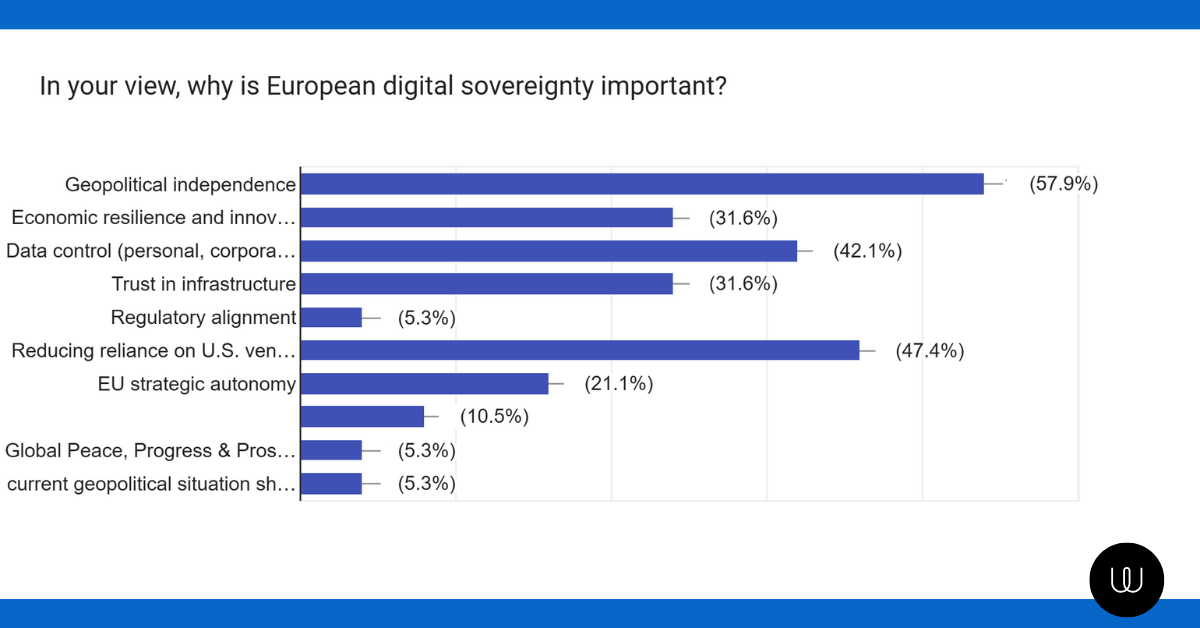Despite growing regulatory momentum - from GDPR to NIS2 - and political ambition, Europe’s digital sovereignty efforts are being met with skepticism on the ground. In our recent survey of 273 decision-makers across public, private, and tech sectors in Europe and beyond, only 15.8% expressed high optimism that the region will achieve digital sovereignty within the next five years.
That’s a signal worth listening to.
While sovereign tech and regulation have advanced, the day-to-day reality for IT leaders, CISOs, and policymakers is much murkier, with adoption friction, awareness gaps, and dependency on U.S. vendors holding things back.
Key Takeaways:
- Only 15.8% are optimistic about achieving sovereignty within 5 years
- Main blockers: user resistance, integration complexity, and low awareness of alternatives
- 84.2% say end-to-end encryption is a top priority
Top 3 Reasons EU Leaders Prioritize Sovereignty
While digital sovereignty is often framed in technical or compliance terms, our survey revealed that strategic and political motivations are driving urgency in 2025. The top reasons respondents gave weren’t abstract ideals, they were deeply pragmatic concerns rooted in Europe’s current technological dependency.

1. Geopolitical Independence
Respondents overwhelmingly pointed to Europe’s structural dependence on foreign powers, particularly the U.S., as a core risk. Sovereignty, in their view, is about autonomy: Europe must ensure its digital backbone isn’t at the mercy of shifting geopolitical tides or extraterritorial laws like the CLOUD Act. This isn’t just policy, it’s about operational control in an age of uncertainty.
2. Reducing reliance on U.S. vendors
Major platforms from Microsoft to Zoom dominate critical infrastructure. Respondents flagged the risk of long-term lock-in, opaque pricing models, and growing exposure to legal and ethical conflicts tied to non-European jurisdictions. Sovereignty means choice and right now, too many organizations feel they have none.
3. Trust in infrastructure and data control
Sovereignty is more than compliance, it’s architecture. EU leaders want communication and collaboration tools that are provably secure, fully auditable, and controllable within EU borders. Open source, self-hosting options, and modern encryption standards (like MLS) are seen as key enablers, not for privacy alone, but for true independence from foreign influence.
What’s Holding Back the Shift to Sovereign Platforms?
When evaluating secure collaboration platforms, end-to-end encryption (84.2%), ease of use (47.4%), and EU data hosting (36.8%) emerged as the most valued features.
Yet paradoxically, most respondents continue using Teams, Zoom, and Slack, platforms that don’t meet their own stated standards for sovereignty.
This disconnect isn’t due to apathy. It’s the result of friction across four dimensions. What’s Blocking the Switch to Sovereign Tools?
- User Resistance: Familiar tools feel easier. Even when more secure options exist, users are reluctant to switch, creating adoption inertia that slows transformation
- Integration Challenges: Alternative platforms often lack plug-and-play compatibility with dominant ecosystems (e.g., Microsoft 365), making transition complex and costly
- Lack of Awareness: Many organizations simply aren’t aware of viable EU-built alternatives like Wire, Tuta, or Nextcloud. Without visibility, adoption lags, regardless of feature strength
- Vendor Lock-In: Long-term contracts and proprietary file formats lock organizations into existing platforms, even when intent to switch is high
Open Source: From Ideal to Essential
When asked about the role of open-source software in their organization’s sovereignty strategy, the message was clear: it matters. Nearly half of respondents (47.4%) called it critical, and another 26.3% labeled it as important. Only one respondent said it wasn’t important - a striking show of consensus in a survey otherwise marked by nuance and caution.
This strong support reinforces a powerful idea: sovereignty and transparency are inseparable. Unlike proprietary tools, open-source solutions allow organizations to verify what’s under the hood: how data is processed, where security gaps may exist, and whether external control is possible. In a landscape where trust must be earned technically, open source offers the visibility and autonomy that many IT and compliance leaders demand.
In short, open source is no longer seen as an alternative, it’s increasingly regarded as a foundational enabler of sovereignty-first strategies.
Regulation: Strengthening, But Not Solving
Regulatory frameworks like NIS2, GDPR, and DORA were seen as supportive but insufficient:
- 47.4% said they “somewhat strengthen” sovereignty
- 15.8% said they “strongly strengthen”
- But over a quarter felt they may actually hinder progress
Why? Because regulation without execution creates compliance theatre — rules are followed, but nothing changes at the infrastructure level.
.png?width=1200&height=628&name=EU%20sovereignty%20report%20(1).png)
Final Takeaways
- Optimism is low - just 16% believe sovereignty is likely in the short term
- Intent is strong - 84% say encryption is non-negotiable, and open source is widely valued
- Execution is the problem - switching is hard, habits are entrenched, and awareness is thin
Until sovereign alternatives become more usable, visible, and integrated, regulation alone won’t be enough. This report is just the beginning. Over the coming weeks, we’ll be publishing a series of deep dives unpacking the biggest blockers to sovereignty adoption, from user friction to integration complexity. Our goal: to turn insights into action, and help European organizations move from intent to implementation.
